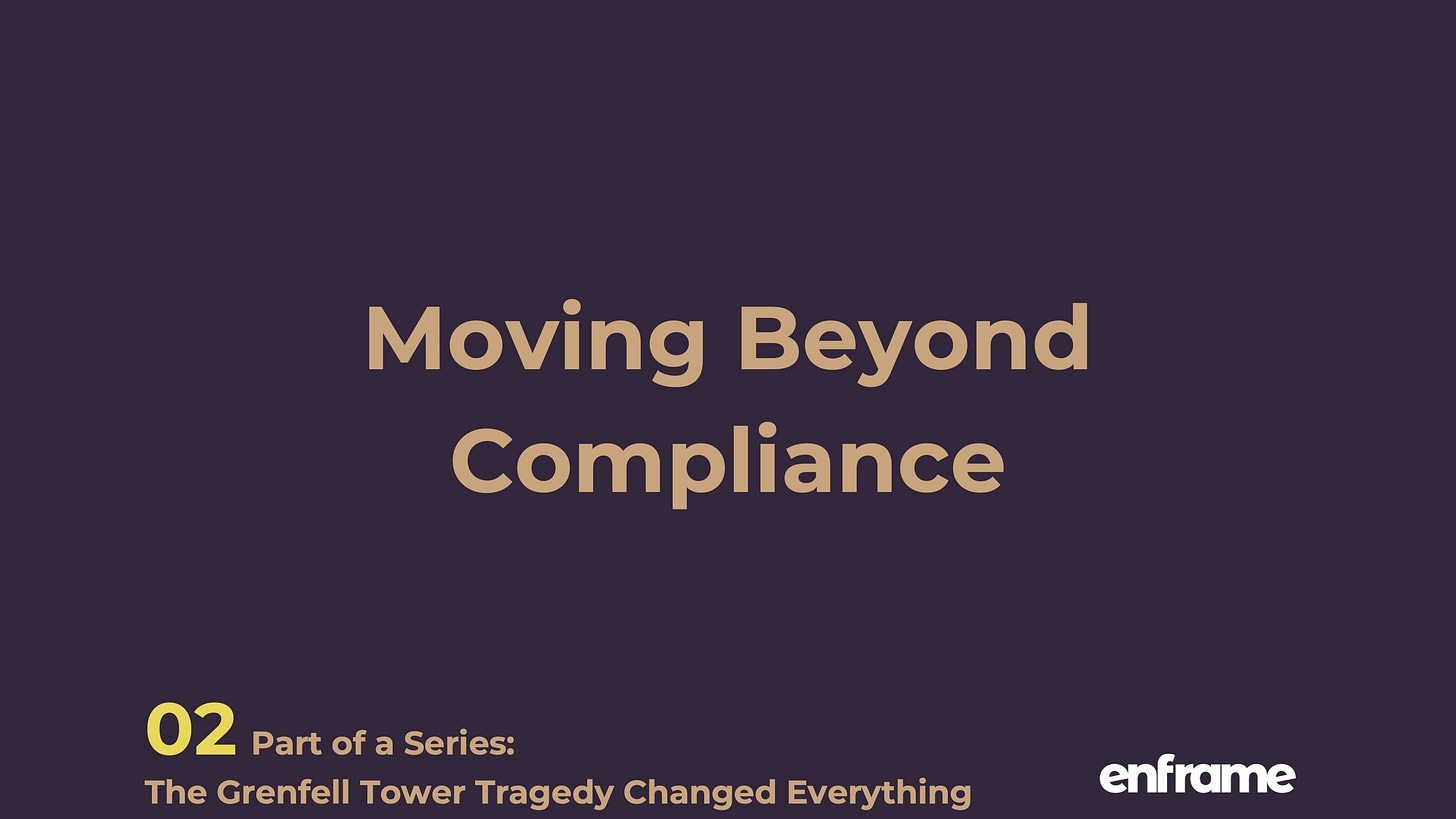Rethinking the Architectural Profession in the Post-Grenfell Era – The Grenfell Tower Tragedy Changed Everything.
Average Reading Time 6m - 920words
Moving Beyond Compliance
The Grenfell Tower tragedy is a stark reminder of the devastating consequences of systemic failures in the construction industry. In the years since, Dame Judith Hackitt has become a leading voice, calling for cultural change, urging the industry to move beyond minimal compliance and towards embedding safety as a fundamental value. Her message is clear: safety should not be viewed as an obstacle or a tick-box exercise but as an integral aspect of good design, planning, and execution.
Dame Judith highlights the importance of the Building Safety Act and the Gateway system in embedding safety into every stage of the design and construction process. She has repeatedly called for early expert involvement, emphasising that architects, as stewards of the built environment, must lead this cultural shift. Her warnings resonate with the findings of the Grenfell Tower Inquiry Phase Two Report, which revealed a widespread lack of competence, accountability, and coordination across the industry.
Changing the culture of an entire sector is no small task. Dame Judith has acknowledged that the construction industry often focuses on meeting the minimum standards, a mindset that can breed mediocrity and risk. To address this challenge, Enframe proposes applying the Marginal Gains principle - a proven approach implemented in other industries that could revolutionise how architects, contractors, and engineers think and operate.
Learning from Marginal Gains: A Proven Framework for Change
The Marginal Gains principle, famously employed by British Cycling to achieve Olympic success, is based on the idea that small, incremental improvements across various areas can lead to significant overall advancements. For construction and architecture, this means breaking down complex processes into manageable tasks and addressing each with small, achievable improvements. While no single action can transform the industry, the cumulative effect of hundreds of improvements could create a safer, more professional, and more respected construction sector.
Taking this approach, opportunities to implement marginal gains in the construction industry include:
Improving the Architectural Curriculum: Incorporate mandatory safety modules, real-life case studies, and cross-disciplinary learning into architectural education.
· Foster Safety-First Culture in Practices: Encourage architects to see safety as a design principle, not a regulatory hurdle, and promote collaboration with fire engineers and building control officers. Ensure that new architects understand the Approved Documents and see safety as integral to design.
Standardising Post-Occupancy Evaluations: Mandate feedback loops to ensure that lessons from building use inform future designs, aligning with the RIBA Plan of Work’s Stage 7.
Creating Specialist Roles: Encouraging architects to specialise in areas like fire safety or climate adaptation, enhancing professional accountability and public protection.
Ensuring Building Regulations Compliance: Restrict Building Regulations applications to regulated professionals, ensuring that critical safety decisions are made by qualified individuals.
Advocate for Fair Working Conditions: Address the industry’s culture of unpaid overtime and minimum wage salaries for architects. Ensure that fees are set at a level that allows for fair pay and reasonable working hours for all professionals.
Create Accessible User-Friendly Guidance: Develop simplified versions of safety regulations, Approved Documents and guidance tailored to builders, specialist contractors and the people they employ. Make resources available in multiple formats to ensure a broader understanding of safety standards.
Each of these measures may seem small or distinct on its own, but collectively represent a profound shift in ways of working, towards a culture where safety, competence, and ethical responsibility are prioritised at every level. Over the next few weeks, we will unpack these, and other ideas and concepts in more detail.
Turning Dame Judith Hackitt’s Concerns into Action
Dame Judith’s call for cultural change is not just an aspiration - it’s a necessity. As she points out, the construction industry’s historic tendency to pass responsibility and prioritise cost over safety has created an environment positioned for failure. Addressing this requires leadership, collaboration, and a willingness to innovate. Marginal gains provide a practical framework for embedding these qualities into daily practice.
By adopting a Marginal Gains approach, the industry can start making meaningful progress today. Imagine a construction sector where architects, contractors, and engineers continuously identify areas for improvement, however small, and implement them with discipline. For example, ensuring that every design complies with the Approved Documents at the earliest stages could prevent costly errors and delays downstream. Similarly, fostering a collaborative culture where architects and contractors work together - rather than in opposition - could lead to safer, more efficient projects.
Drawing from other professions like veterinary science and law, we see the power of regulatory oversight combined with a culture of accountability. Architects could embrace this model, strengthening their governance and creating clearer pathways for specialisation, such as the development of Principal Designer roles or climate adaptation experts.
A Roadmap for Cultural Change
Dame Judith Hackitt’s concerns remind us that cultural change is both a top-down and bottom-up process. It requires leadership at all levels. Regulators, professional bodies, and government agencies must set the tone by mandating better practices and holding professionals accountable. At the same time, individuals across the industry must take ownership, committing to continuous improvement and collaboration.
By integrating the lessons of marginal gains, the architectural profession can lead this transformation. Each small step - whether it’s improving safety education, adopting new design technologies, or standardising regulatory compliance - brings us closer to a construction industry that values people over profit. In doing so, we honour the memory of Grenfell Tower’s 72 victims and build a future where such tragedies are not only unimaginable but impossible.
We invite you to engage with our work, share your insights, and join us in this transformative journey.
We invite you to engage with our work, share your insights, and join us in this transformative journey.
You can find us at




